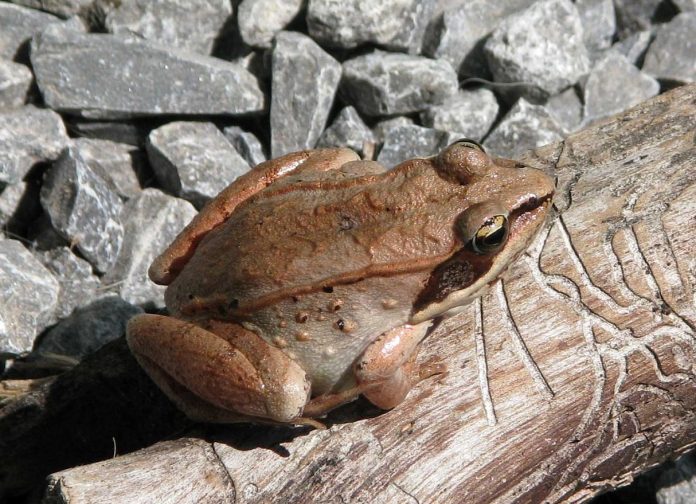It’s a little early to hear bullfrogs and toads, but wood frogs always get a head start on spring. As soon as ice and snow melt, they emerge from woodland leaf litter and sing.
A wood frog’s voice is more duck-like than frog-like.
A group always reminds me of a flock of quacking mallards. Wood frogs are active by day and lead solitary lives, except during the brief mating season, which has already begun.
They can grow to a length of three inches, but most are smaller. The best field mark is a dark mask that widens from nose to shoulder.
Otherwise, a wood frog’s tan body blends in perfectly with the leaf litter on the forest floor. When air temperatures reach 50 degrees, males move to small ponds and even small depressions that collect snow melt and runoff.
Females arrive
Here they sing, and within a day or two, curious females arrive. Females lay as many as 700 eggs, which the males fertilize as females release them. Often many breeding adults visit these sites where masses of thousands of eggs are possible.
After about a week, the egg mass flattens out, allowing it to rest on the surface of the water. Individual eggs consist of small black spheres (the embryos) surrounded by a clear gelatinous mass. They incubate in the water for up to a month, though hatching depends on temperature.
At 45 degrees, for example, eggs hatch in about 20 days. Eggs in the center of the mass have an advantage that may explain the rush to breed. The temperature in the middle of an egg mass can be as much as 12 degrees warmer than ambient temperature, so those eggs hatch sooner than those on the perimeter.
Therefore, centrally located eggs hatch first. Wood frog tadpoles begin life less than a quarter-inch long and can reach a length of two inches over the next three months. Then they transform into adult frogs, which require two years to reach sexual maturity.
Under rocks
Red-backed salamanders are another amphibian that can be found in early spring. They spend about 90 percent of their time under rocks, logs, and leaf litter, so they are seldom seen — unless you look for them.
Flip rocks and roll logs when you walk in the woods (be sure to return them to their original position), and you’ll almost always find a few red-backed salamanders. Population densities of red-backed salamanders can range from 800 to 8,000 per acre.
In some Appalachian forests, the biomass of red-backed salamanders exceeds that of all the birds and mammals that occupy the same area. Red-backed salamanders measure three to four inches from snout to tip of tail and are found from Minnesota eastward to the Maritime Canadian provinces and south to North Carolina.
Curiously, they belong to a family of lungless salamanders. They respire directly across their moist skin. Because red-backs are so abundant, they play an important role in forest food webs.
They’re active predators and eat just about anything they can catch. Their menu includes ants, termites, beetles, earthworms, spiders, snails, slugs, mites, springtails, centipedes, and millipedes. One study estimated that red-backs eat nearly _-million prey items per acre per year.
Food for others
On the other hand, red-backs are also important food for small forest snakes, shrews, voles, chipmunks, and birds that forage in the leaf litter. Towhees come immediately to mind.
Surprisingly, red-backed salamanders usually breed in the fall. Though males breed every year, females in the northern part of their range breed every other year. Apparently, it takes northern females more than a full year to generate energy-rich yolks for a full clutch of eggs.
The eggs, usually two to 14, are laid in grape-like clusters in natural cavities and crevices under rocks and logs. They are pale, less than a quarter-inch in diameter, and enveloped in gelatinous material.
The female coils around the eggs to protect them from predators and prevent them from drying out during the six-week incubation period. After hatching, juveniles remain in the nest with the female for several weeks before dispersing.













